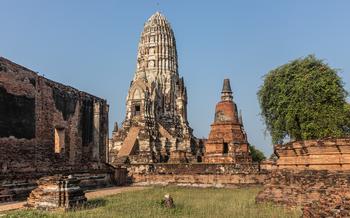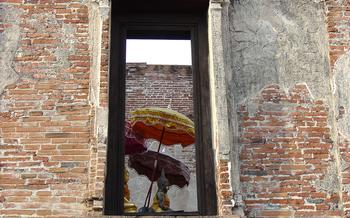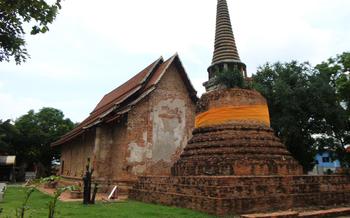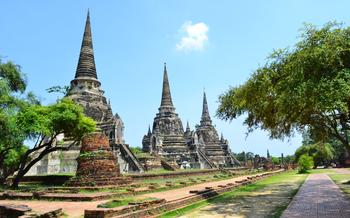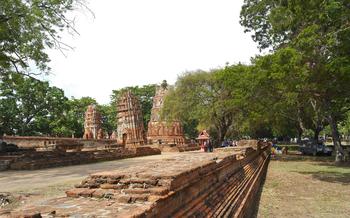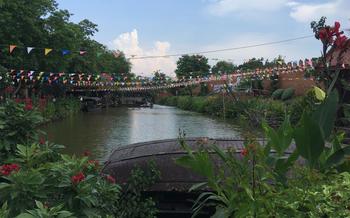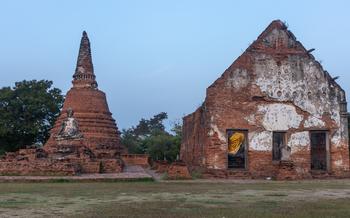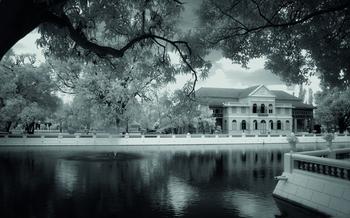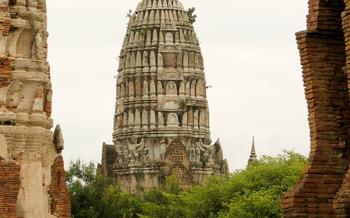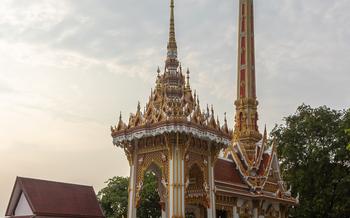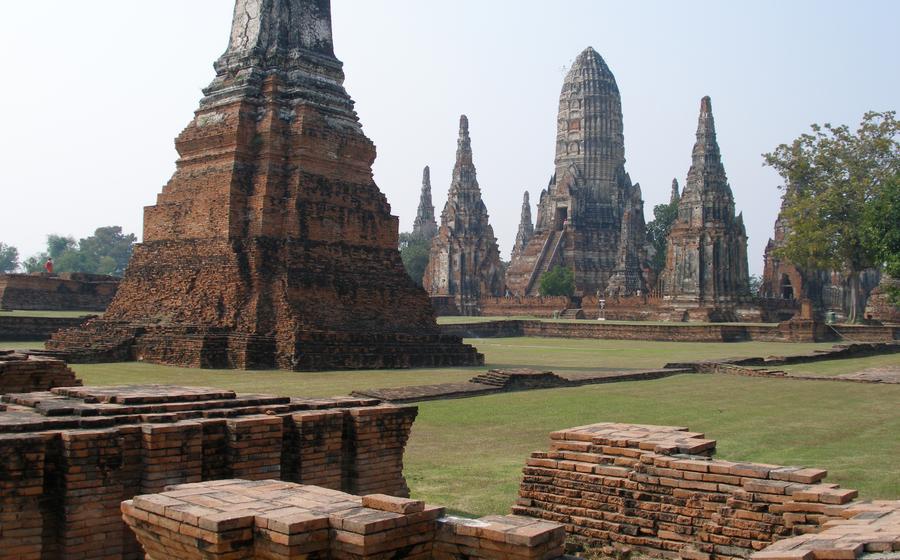
Wat Phrao
- Wat Phrao: A Testament to Ayutthaya's Grandeur
- Exploring the Grounds of Wat Phrao
- Royal Connections
- Surrounding Attractions
- Best Time to Visit
- Getting There
- Admission and Fees
- Dress Code and Etiquette
- Photography and Videography
- Accessibility
- Local Cuisine
- Souvenirs and Handicrafts
- Local Festivals and Events
- Insider Tip: Discover the Hidden Gem of Wat Phrao
Wat Phrao: A Testament to Ayutthaya's Grandeur
Wat Phrao stands as a testament to the grandeur and resilience of the ancient Ayutthaya Kingdom. Its construction, commissioned by King Naresuan the Great, marked a pivotal moment in Ayutthaya's history, solidifying its position as a powerful and independent kingdom. As a royal temple, Wat Phrao served as a sacred ground for significant ceremonies and rituals, witnessing the triumphs and trials of the Ayutthaya dynasty. Despite the devastating destruction of Ayutthaya in the 18th century, the temple remarkably survived, a testament to its enduring strength and spiritual significance.
Exploring the Grounds of Wat Phrao
Wat Phrao's grounds offer a captivating journey through history and spirituality. The main structures include the ubosot, viharn, and prang, each showcasing unique architectural features and religious significance. The ubosot, also known as the ordination hall, is where Buddhist monks undergo ordination ceremonies. It houses a large Buddha image seated in the meditation posture, surrounded by intricate murals depicting scenes from the Buddha's life. The viharn, or assembly hall, serves as a gathering place for monks and laypeople to listen to teachings and participate in religious ceremonies. It features a series of Buddha images in various postures, each representing different aspects of the Buddha's teachings.
The prang, the towering spire that dominates the temple complex, is the most iconic structure at Wat Phrao. It symbolizes Mount Meru, the center of the universe in Buddhist cosmology. The prang's surface is adorned with intricate carvings and sculptures depicting mythical creatures, celestial beings, and scenes from Buddhist mythology. These carvings provide valuable insights into the beliefs and practices of the Ayutthaya people. Visitors can climb the steep stairs to the top of the prang for panoramic views of the temple grounds and the surrounding countryside. Other notable features within the temple complex include a large reclining Buddha, a chedi (stupa), and a collection of Buddha images in various sizes and styles. Each of these elements contributes to the rich tapestry of Wat Phrao's architectural and religious heritage.
Royal Connections
Wat Phrao's close association with the Ayutthaya royal family is evident in its role as a venue for important ceremonies and events. The temple's grand architecture and sacred atmosphere made it a fitting setting for royal coronations, weddings, and other significant occasions. Throughout its history, Wat Phrao witnessed many momentous events that shaped the destiny of the Ayutthaya Kingdom.
The temple grounds are adorned with several royal inscriptions and artifacts that attest to its connection with the monarchy. These inscriptions, often etched on stone tablets or stelae, record royal decrees, historical events, and the contributions of various kings to the temple's construction and maintenance. Visitors can explore these inscriptions to gain insights into the lives and reigns of Ayutthaya's rulers.
Wat Phrao's royal connections are not limited to the past. Even today, the temple holds a special place in the hearts of the Thai people, serving as a symbol of the enduring legacy of the Ayutthaya Kingdom. Its grand architecture, historical significance, and spiritual aura continue to attract visitors from all over the world, who come to pay homage to the temple's royal heritage and experience a glimpse of Thailand's rich cultural and historical tapestry.
Surrounding Attractions
In the vicinity of Wat Phrao, visitors can explore several other notable places and landmarks that offer a glimpse into Ayutthaya's rich history and culture. Just a short walk away is the Wat Mahathat, another significant temple known for its iconic prang that has become a symbol of Ayutthaya. Visitors can marvel at the intricate carvings and sculptures that adorn the temple, as well as the impressive collection of Buddha images.
Wat Phanan Choeng, located a few kilometers from Wat Phrao, is another must-see attraction. This temple is renowned for its large reclining Buddha, which measures over 40 meters in length. Visitors can pay their respects and admire the serene beauty of this impressive statue.
For those interested in history, the Ayutthaya Historical Park is a must-visit. This UNESCO World Heritage site encompasses the ruins of the ancient city of Ayutthaya, including palaces, temples, and fortifications. Visitors can explore the park on foot or by bicycle, and learn about the fascinating history of this once-great kingdom.
To create an itinerary that includes multiple attractions in the area, visitors can start with Wat Phrao and then visit Wat Mahathat and Wat Phanan Choeng on foot. The Ayutthaya Historical Park is a bit further away, but can be reached by tuk-tuk or bicycle. By combining these attractions, visitors can gain a comprehensive understanding of Ayutthaya's rich cultural and historical heritage.
Best Time to Visit
The ideal time to visit Wat Phrao is during the cool and dry season, which runs from November to February. During this period, the weather is pleasant, with average temperatures ranging from 20 to 30 degrees Celsius. The skies are clear, and there is little chance of rain, making it ideal for outdoor exploration. Additionally, the cooler temperatures make it more comfortable to spend extended periods of time walking around the temple grounds.
While the shoulder months of March and October can also be suitable for visiting Wat Phrao, it is essential to be aware of the potential for occasional showers. However, the advantage of visiting during these months is that there are fewer crowds, allowing for a more peaceful and immersive experience.
It is generally advisable to avoid visiting Wat Phrao during the rainy season, which lasts from June to September. Heavy rainfall and the possibility of flooding can make it challenging to explore the temple grounds comfortably. Furthermore, the high humidity levels can make it uncomfortable to spend extended periods of time outdoors.
Getting There
Reaching Wat Phrao from Bangkok or other major cities in Thailand is a relatively straightforward journey. Multiple transportation options are available, catering to different preferences and budgets.
By Bus: For a budget-friendly option, regular buses depart from Bangkok's Northern Bus Terminal (Mo Chit) to Ayutthaya. The trip takes approximately 5 to 2 hours, and tickets can be purchased at the terminal. Once in Ayutthaya, take a local bus or tuk-tuk to Wat Phrao, which is about 3 kilometers from the city center.
By Train: For a more scenic journey, trains depart from Bangkok's Hua Lamphong Railway Station to Ayutthaya. The train ride offers beautiful views of the countryside and takes about 1 hour and 45 minutes. From Ayutthaya Railway Station, take a taxi or tuk-tuk to Wat Phrao.
By Taxi: For a convenient and direct option, taxis can be hired from Bangkok or Ayutthaya to Wat Phrao. The journey takes approximately 1 hour and 30 minutes from Bangkok and costs around 1,500 to 2,000 THB (45 to 60 USD).
To avoid traffic congestion, it's advisable to depart early in the morning or late afternoon, especially when traveling from Bangkok. For a hassle-free experience, consider booking a guided tour that includes round-trip transportation from your hotel in Bangkok or Ayutthaya.
Admission and Fees
Visiting Wat Phrao is a budget-friendly experience, with an entrance fee of only 50 THB (approximately 50 US dollars) per person. This fee includes access to all areas of the temple grounds, including the ubosot, the viharn, and the prang. Visitors who are interested in exploring other attractions in Ayutthaya can purchase a combined ticket that includes admission to multiple sites at a discounted rate.
There are no additional fees for photography or videography within the temple grounds, as long as visitors adhere to the guidelines and restrictions in place. Guided tours of Wat Phrao are also available for those who wish to learn more about its history and significance. These tours typically cost between 200 and 300 THB (approximately 6 to 9 US dollars) per person and can be arranged through local tour operators or guides.
Dress Code and Etiquette
When visiting Wat Phrao, it is essential to dress respectfully, as it is a sacred religious site. For men, this means wearing long pants that cover the knees, and a shirt that covers the shoulders. Shorts, tank tops, and sleeveless shirts are not appropriate attire. For women, it is recommended to wear a skirt or pants that cover the knees, and a shirt or blouse that covers the shoulders. Revealing or transparent clothing should be avoided.
Upon entering the temple grounds, it is customary to remove one's shoes and leave them in the designated shoe rack. It is also considered polite to bow or wai (a traditional Thai greeting) to the Buddha images as a sign of respect. When walking around the temple, it is important to be mindful of one's behavior and to avoid making loud noises or being disruptive. It is also advisable to refrain from touching or climbing on the Buddha images, as they are considered sacred objects.
Photography and Videography
Photography and videography are generally allowed within Wat Phrao, allowing visitors to capture the temple's beauty and grandeur. However, it is essential to be respectful and mindful of the sacred nature of the site. Flash photography is strictly prohibited, as it can damage the delicate murals and sculptures. Instead, utilize natural light or a tripod to achieve well-lit shots.
When taking photos, be mindful of the people around you and avoid obstructing their worship or meditation. It is considered polite to ask permission before photographing individuals, especially monks or nuns.
For those seeking truly exceptional photographs, consider hiring a professional photographer who can guide you to the best vantage points and help capture the essence of Wat Phrao. They can also provide insights into the temple's history and significance, making your visit even more memorable.
Accessibility
Wat Phrao is generally accessible to visitors with disabilities. The temple grounds are mostly flat, with paved pathways that allow for easy wheelchair navigation. However, it's important to note that some areas of the temple, such as the upper levels of the prang or the chedi, may not be accessible due to the lack of ramps or elevators. Visitors with mobility issues may need assistance or alternative ways to experience these areas.
For wheelchair users or those with limited mobility, it's advisable to inform the temple staff or tour operator in advance so that they can provide assistance if needed. The staff may be able to arrange for a golf cart or other means of transportation within the temple grounds. Additionally, visitors can request to be seated in the front rows during ceremonies or events to ensure a clear view and avoid any obstacles.
Local Cuisine
When visiting Wat Phrao, one should not miss the opportunity to indulge in the delectable local cuisine that Ayutthaya has to offer. The area surrounding the temple is home to a variety of restaurants and street food stalls serving up authentic Thai dishes that will tantalize your taste buds.
For a truly local experience, try the boat noodles, a specialty of Ayutthaya. These delicious noodles are served in a rich and flavorful broth made from pork bones and spices, and are often topped with pork balls, crispy pork belly, and fresh vegetables.
Another must-try dish is Pad Thai, a stir-fried noodle dish that is considered Thailand's national dish. Pad Thai is made with flat rice noodles, shrimp, chicken, eggs, and a sweet and tangy sauce.
For a refreshing dessert, try mango sticky rice, a popular Thai treat made with sweet, ripe mangoes served with glutinous rice that has been cooked in coconut milk.
When looking for places to eat near Wat Phrao, there are several options to choose from. One popular spot is the Ayutthaya Floating Market, where visitors can sample a variety of Thai dishes from vendors selling their wares on boats.
For a more upscale dining experience, try one of the many restaurants located in the Ayutthaya Historical Park. These restaurants offer a variety of Thai and international dishes, as well as stunning views of the ancient ruins.
No matter where you choose to eat, be sure to try some of the local specialties to get a true taste of Ayutthaya's culinary delights.
Souvenirs and Handicrafts
When visiting Wat Phrao, take the opportunity to explore the nearby shops and stalls that sell a variety of souvenirs and handicrafts. These items are not only beautiful but also hold cultural and religious significance. Look for Buddha images in various sizes and materials, from small amulets to larger statues. Amulets, or "phra khruang," are believed to bring good luck and protection, and many people wear them as talismans. Traditional Thai clothing, such as silk scarves, sarongs, and hand-woven fabrics, is also a popular choice. These items are not only stylish but also support local artisans and help preserve traditional Thai craftsmanship. Whether you're looking for a unique gift or a meaningful keepsake, Wat Phrao's surroundings offer a treasure trove of authentic and high-quality souvenirs.
Local Festivals and Events
Ayutthaya's vibrant cultural heritage is reflected in its numerous festivals and events that showcase the city's rich history and traditions. One of the most significant festivals is the Ayutthaya Historical Study Fair, held annually in February. This colorful event brings the past to life with historical reenactments, traditional performances, and exhibitions that delve into the glorious era of the Ayutthaya Kingdom. Visitors can witness grand processions, marvel at ancient crafts, and immerse themselves in the grandeur of this bygone era. Other notable events include the Loi Krathong and Yi Peng festivals, where locals release floating lanterns and sky lanterns into the night sky, creating a magical spectacle that symbolizes letting go of past misfortunes and welcoming good fortune. To fully experience Ayutthaya's festive spirit, plan your visit to coincide with one of these vibrant celebrations and immerse yourself in the city's infectious energy.
Insider Tip: Discover the Hidden Gem of Wat Phrao
Beyond the main attractions of Wat Phrao, there lies a hidden gem waiting to be discovered. Tucked away in a secluded corner of the temple grounds, visitors can find a serene and picturesque lotus pond. This tranquil oasis offers a respite from the crowds and a chance to connect with the natural beauty of the temple. Visitors can take a moment to sit by the pond, admire the vibrant colors of the lotus flowers, and find a sense of peace and tranquility. It's the perfect spot to escape the hustle and bustle of the temple and enjoy a moment of quiet contemplation.
